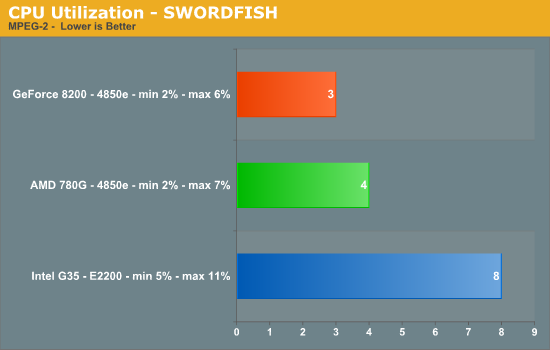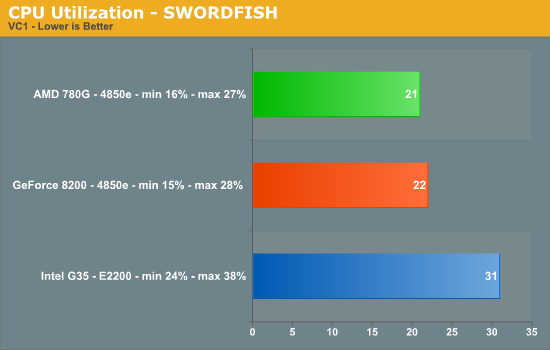AMD 780G: Preview of the Best Current IGP Solution
by Gary Key on March 10, 2008 12:00 PM EST- Posted in
- CPUs
Testing Notes
Our image quality tests today consists of still screenshots from several movies in our collection, actually the primary criteria were movies that offered decent bitrates and were screen capture friendly under DRM infested Vista. While we tried to capture the exact moment within a frame to compare the 780G to the G35/GF8200, this was not always possible. However, we did our best to capture the screenshots on the same frame but at times; the capture process grabbed the beginning of the frame or the trailing end.
In the end, we feel like the process is close enough to give you an indication to any differences between the images. Obviously, we cannot show the reference image but will comment as to which screen shot best represented the reference image on our home theater system. We find measuring video output quality in this manner a subjective process to some degree, as at times we liked an image that did not match the reference screenshot better than the one that did. Considering that fact, we decided to bring eight people in to give us their opinions during playback sequences and then still-shot reviews.
We utilized PowerDVD 7.3 (build 3610 utilized, 3730 in testing) for playback with all settings on auto, except we enabled hardware acceleration within the application. We measured CPU utilization and bitrate results with the Vista Task Manager and PowerDVD Info applications respectively. We took readings every five minutes and averaged the results at the end of the movie. Movies were played back in full screen mode at their native resolutions with the desktop set to 1920x1200. We will show discrete card results in our next article. However, the HD 3450 provided results that were just a few percent better than the HD 3200 with the released 8.3 driver set.
Audio settings selected were Dolby Digital 5.1, DTS 5.1, or two-channel LPCM where applicable. Unlike the 780G, the G35 and GeForce 8200 fully supports multi-channel LPCM output and we will comment on results with either LPCM 5.1 or Dolby TrueHD decoded streams (via PowerDVD) where applicable.
We calibrated both systems on our Gateway XHD3000 monitor to ensure the color palettes were set equally. Fine tuning the control panel settings for each of the test setups can and will improve the picture quality but we will leave that up to the user to decide their preferences. We played back the movie sequences on the Gateway monitor for initial viewing and judging. We proceeded to output the same movie sequences on our calibrated Samsung 61" (HL-T6187S) DLP set utilizing the same control panel and PowerDVD settings to view the images in an HT setting.
We then utilized our test setups to pass through the image and audio via HDMI to our Pioneer Elite VSX-94THX A/V receiver. Using the receiver as a "repeater", we output the native signal (our preferred method to PWDVD) to our HT setup (7.1 audio/Samsung 61” DLP) for our test subjects. We will list their preferences in our comments section. We will also warn you in advance that the original images are generally 2MB to 3MB in size if you decide to download them.
MPEG 2 Video Quality - SWORDFISH
We are utilizing the movie SWORDFISH from Warner Brothers, what else can we say, we still like seeing Halle Berry in the lounge chair. This movie offers bitrate levels that averaged 5.4 Mb/s to 8.1 Mb/s on average. In our particular test scene, John Travolta is drinking a cup of coffee in a close up shot that highlights skin tones along with reflections off the cup and background objects.
 780G – Click to Enlarge |
 G35 – Click to Enlarge
|
 GeForce 8200 – Click to Enlarge |
The differences in the images are minor but the G35 appears to have slightly deeper colors along with a slight edge in sharpness while the GeForce 8200 offers additional contrast and a better background image, but being darker overall. However, the 780G image was faithful to the reference image during playback tests. Our test audience placed 4 votes for the 780G, 2 for the G35, and 2 for the GeForce 8200.

CPU utilization during playback favors the 780G and GeForce 8200 on average by 4%. This was surprising to us as the G35 does not offer full hardware decode capabilities for MPEG-2 playback. However, we never had a problem with playback in this title and others such as Cars and Spiderman 3.
VC1 Video Quality - SWORDFISH
SWORDFISH is not a very demanding movie in 1080P playback but the image screenshots should give a good indication to the improvement when going from MPEG-2 to VC1. This movie offers bitrate levels that averaged 15.7 Mb/s to 25.2 Mb/s on average. Once again, we utilize the coffee shop test scene.
 780G – Click to Enlarge |
 G35 – Click to Enlarge |
 GeForce 8200 – Click to Enlarge |
The differences in the images are once again minor but this time the 780G appears to have better skin tones while sharpness and overall color palette seems to favor the G35. We thought the GeForce 8200 image was slightly on the flat side when comparing facial details but had the best background details. The 780G image was more faithful to the reference image during playback tests. The 780G garnered 3 votes, 3 to the G35, and 2 for the GeForce 8200.

CPU utilization during playback favors the GeForce 8200 and 780G by a several percent even though the G35 offers hardware accelerated decoding of the VC1 format. There were not any judder or stuttering problems on any of the platforms during playback.










49 Comments
View All Comments
yehuda - Wednesday, March 12, 2008 - link
Yes, these are upcoming Intel boards based on the next-gen G45/Q45 chipsets. Thanks for the link.The thing is that dual digital boards could have been here today. The 780G boards from Asus and Gigabyte too have DVI+HDMI on the back panel. My complaint is that they won't let you run both ports at the same time, even though the IGP supports that.
psychobriggsy - Monday, March 10, 2008 - link
It's really good to see AMD doing something well.Well, apart from the southbridge, but at least the USB2 performance issues are fixed, and otherwise most people will never notice the few differences.
Great chipset for HTPC though. Here's hoping to see what a few more driver revisions can do!
samivesusu - Monday, March 10, 2008 - link
http://www.youtube.com/watch?v=rcbGV6Pfb6Q">http://www.youtube.com/watch?v=rcbGV6Pfb6Qgoinginstyle - Monday, March 10, 2008 - link
Thanks for the image comparisons. I think it is about time that somebody showed HD images from actual titles instead of quicktime trailers. Looking forward to the roundup but mainly more image comparisons and quad-core results for the boards. Is a Q6600 on the G35 going to make the stutter/judder problem go away for h.264 titles? Any chance of audio tests with the boards?TheJian - Monday, March 10, 2008 - link
Why would you run a quadcore without a REAL video card? You're missing the whole point of this chipset in that case. Which is HTPC market and the CHEAPO CPU market playing games. This is the best HTPC chipset out there. You can run a SEMPRON 1.8ghz chip as TomsHardware showed a few days ago. That's a SINGLE CORE chip. No need for Dual cores they tested here. IF you have the money for a quad core surely you have $190 for a 8800GT. Why would I want Integrated graphics with a quad core?Ajax9000 - Tuesday, March 11, 2008 - link
Well, one reason is that IGP-to-HDMI is currently the only way to get better than AC3-class digital audio out of an HTPC (due to the lack of OS kernel-level protected audio path for user accessible buses).... which highlights the strange design of the 780G -- the Southbridge can do Intel HD Audio, but the Northbridge is limited to AC3-class audio.
sprockkets - Thursday, March 13, 2008 - link
Or as mentioned L 2.1. Is there anyone that actually notices the difference in audio quality?Hey, I wish someone also tested how the Intel nVidia 7xxx series chipset does. Since it has only one memory channel, it must make it all suck.
Gary Key - Tuesday, March 11, 2008 - link
I have tested this board with a Sempron 64 3400+ and did not have the same results as Tom's with our hardware and driver setup. I am still working on the numbers but the H.264 (AVC) playback experience was not that pleasurable with our video titles. Yes, playback was possible but any system level requests or bitrate spikes above 40Mbps resulted in judder or stuttering. We will look at the lowest common hardware denominator from a CPU/GPU viewpoint in an HTPC focused article next month. We just shipped a 780G board to our Linux editors to test. Hopefully, we can have some initial results early next month.goinginstyle - Tuesday, March 11, 2008 - link
It might be the fact that I can afford a Q6600 or Phenom by not buying a separate video card. The whole point of having a quad is to setup a encoding system that will not take 14 hours to encode a single movie like my Celeron took. I wish this chipset was available for the Intel cpus but I have to admit that my gigabyte 780g board with a 9500 Phenom is working very well right now. After reading about the post processing information, I am glad I bought a phenom. Now I wonder if a Q6600/G35 would have been better if that combo does not choke on AVC materials.